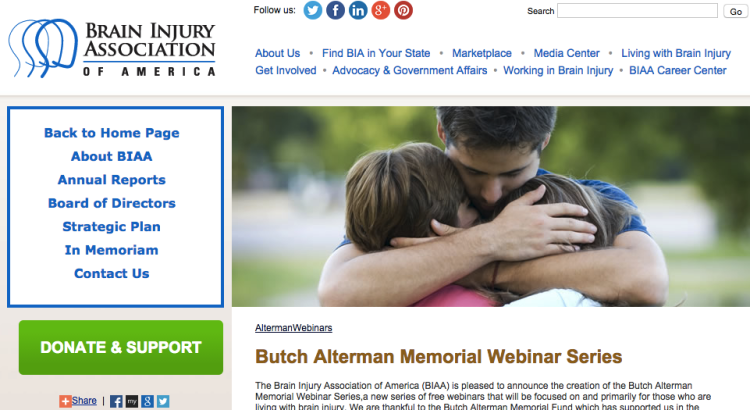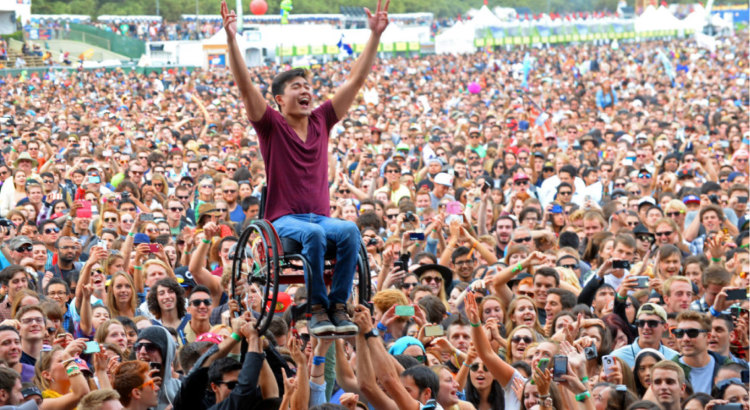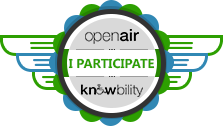One of the many highlights of this week, was getting to listen to Maria Romanas, MD PhD talk during a Butch Alterman Webinar through the Brain Injury Association of America (BIAA).
The webinars are FREE. You must register for them. You can download handouts even if you did not watch or register to watch.
I will provide the links at the end of this post so that you can learn about future webinars, and download handouts from past ones.
Before I write down what I learned from the webinar last week, I want to step back and explain about this new webinar Series through BIAA.
The Butch Alterman Webinar Series:
The Butch Alterman Webinar series is a relatively new series. It was started in 2014 and there have already been 4 webinars (including Maria Romanas’s)
It is a webinar series for people with brain injury by people who have gotten better after brain injury and who have been selected to share their understanding, strategies or knowledge from their journey and from their hard-fought experience and learning about what helped them.
The series was created by Mo Alterman, in memory of her husband, Butch who had had a brain injury. Butch Alterman was a teacher by profession.
After he died, the series was created by his wife to honor her husband’s belief in the importance of teaching.
I am fortunate that I got to meet Mo Alterman years ago. Mo was the President of the Board at BIAA in the early 2000’s. I started volunteering at BIAA in about 2003, after we returned to Washington DC. At the time, I could not get help matching the skills I had post-injury with a job opportunity. After I met Robert Demichalis, a volunteer at BIAA, he invited me to share his office and use a second desk in his office. I thought it would be a great opportunity to learn what job skills I actually had and learn about the Brain Injury Association of America.
Back to Mo. I was impressed by her because she was tough and outspoken and a tireless advocate for people with brain injury. She believed in the importance of improving the lives of people with brain injury. Of course, she was not alone in that belief at BIAA, it was just that she was passionate and I “got her” immediately. My experience working with the staff and people who volunteer their time and energy to BIAA is that they all want to improve the lives of people with brain injury. I have over 10 years of experience volunteering at BIAA and I have both received tremendous support in my journey to recovery and I have learned an incredible amount of helpful information from them. I have also contributed from my perspective as a person with brain injury in many ways. (My volunteer work is another blog post which still needs to be written!)
One last thing about Mo. I felt very drawn to Mo as a leader, just like many others did. Her dedication and passion were inspiring. And her knowledge about brain injury and her own personal journey to help her husband get the resources he needed were obvious in her command of the issues.
Here are the links to get information and register for the Butch Alterman Webinars:
Some tips about the links and technology:
With my cognitive and visual issues from my brain injury, I often have a difficult time finding information on many websites. To summarize, I often cannot even find where on the website the information I need lives, trying to find it may increase my frustration to intolerable levels, and I leave the website empty handed, frustrated, and angry. Worse, being on a really busy website may set off headaches or other symptoms and depending on the stage of recovery I am in, and thus I may have to get emergency cognitive rest, or change my day in order to get over the damage that the busy website has done to my wellness.
On any given day, I can have problems with the Brain Injury Association of America’s website because it is very busy.
So I want to help others who may have some of the same issues with finding and using what they need on websites the information that may help them.
Having been empowered by my accessible technology team at Cognizant and my advisor, Joseph Karr O’Connor, I want to pass on what I have learned so that you may be able to take advantage of this excellent Webinar series at BIAA and the resources that it makes available to you.
Before you click on any of the links below, please read through to the bottom so you will know what to expect.
Writing down the steps before you press a link may be helpful.
Writing things the steps for yourself on a blank piece of paper will help imprint the steps in your brain.
You may want to rearrange the steps once you have written them down, depending on what makes sense for your deficits and the way your brain works.
And remember, in trying to sign up for a webinar, you are both doing something new and trying to follow many steps.
Give yourself plenty of time and space to do this, and recognize that you may not get it right the first time, and that is okay.
As Dr Maria Romanas will tell you in her talk, doing anything that is new, is harder.
As Dr Maria Romanas recommends for starting any new task, take two deep breaths before you try to execute these steps.
And remember, that people with out brain injuries, may have a difficult time following these steps as they may not have been optimized as well as possible for someone learning for the first time and finding the right buttons. I know that my husband, someone who works in on-line technology has told me that often websites will say press here, and they have not put a button on that page to press. Frustrating for anyone even if your brain works fine.
Below is the link that tells you about the Webinars series:
Click on it.
http://www.biausa.org/education/altermanwebinars
If you want to register for the Webinar:
Click the link below.
http://www.biausa.org/biaa-events.htm
Once you have clicked on it, scroll down to the midway down the page until you find the upcoming Alterman Webinair.
If you want to download handouts for the a Webinar, or a past one:
Click on the link below;
http://www.biausa.org/education/altermanwebinars
Scroll down to the heading that says Recording and Handouts of Previous Alterman Webinars.
Click on first link after the webinar handouts that you want.
Lastly, I have learned the trick of using Google to search the BIAA website. I put “Butch Alterman Webinars at Brain injury Association of America” in the search bar and that worked.
I need your feedback!
Do you have problems with searching and finding information on websites? Please leave me a comment and describe tips that help you.
Also, I will have to think about what the best way to give these links and improve them. Please give me feedback if you were able to use them or better ways to write them so that they are easy to go to.
Having tried to make my website more accessible, I know that sometimes finding what works best is trial and error and I would like to learn more about what works best.
Read More - New Webinar series at BIAA by people with brain injury for their peers





Recent Comments